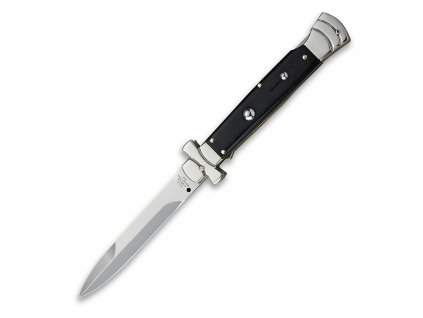Böker Manufaktur Solingen Tiger-Damast
Code: 111103DAMRelated products
Product detailed description
The straight-bladed Böker Tiger Damascus features a unique damascus blade made from the steel of a battle tank destroyed in the Battle of Bauska. The stainless steel mosaic damascus was hand-forged by Chad Nichols from the Intrepid pattern and is reminiscent of the marks left in the ground by the heavy tracks of the Tiger tank. Unlike conventional damascus, mosaic damascus is not made in layers, but the intricate damascus bars are hand forged into mosaic in an elaborate and highly complex process.
The ball-bearing blade opens with the thumb and locks with a sturdy stonewash-coated steel lock, with a Hinderer lock-stop safety serving as a lock override. The overall shape of the knife pays homage to the famous tank lines, while the decorative knife axis bolt is modeled after the main drive wheel. The mildly contoured jute micarta handle scabbards have precisely milled grooves that recall the characteristic Zimmerit coating texture of German armored vehicles. With lanyard loop and milled clip (tip-up/r) with steel ball. Handmade in the Böker knife manufactory in Solingen.
With certificate of authenticity and individual serial number.
The tank parts used to make the steel for this knife came from a Tiger I tank of the 502 Heavy Tank Division, which was destroyed in combat in Latvia in the summer of 1944 in a heavily wooded area near the town of Bauska. Based on debris found at the original excavation site, it was determined that this Tiger was an early to mid-model. Examination of the damage to the remains, military records and local historical accounts revealed that this Tiger tank collided with a Russian T-34 medium tank and an SU-76 self-propelled gun, and was also damaged by a 45 mm calibre stationary anti-tank gun. It is not yet clear which of the impacts caused the most damage and sealed the Tiger's fate. However, because several 76 mm shrapnel lodged in the heavy armor, it is believed that the decisive hits were delivered to a nearby T-34 before it too was destroyed at a distance of 300 meters.
Otto Carius and Albert Kerscher, two of the most successful tank commanders of World War II, were then with Heavy Armored Division 502 trying to stop the Soviet advance on Riga. The division managed to so overwhelmingly defeat the enemy blockade force at Tukums that it was able to retreat to Kursk, Latvia, along with more than 500,000 Army Group North troops. There the troops were encircled in the further advance of the Soviet troops. The Kurland Cauldron served as a bridgehead and could be supplied by the Kriegsmarine by sea. It withstood six major attacks by Soviet troops until its unconditional surrender on 8 May 1945.
Overall length: 19.80 cm
Blade length: 8.50 cm
Blade thickness: 3.60 mm
Weight: 141 g
Blade material: Damascus
Handle material: Micarta
Lock: Framelock
Made in Solingen
Additional parameters
| Category: | Classic folding knives |
|---|---|
| Blade material: | damascus |
| Blade length: | 8 to 10cm |
| Handle material: | micarta |
| Aktualizace: | BOKER24 |
Be the first who will post an article to this item!

Böker - the history of the factory dates back to the 17th century, the original forge was then located in Remscheid. In 1829-30, production was extended to sabres and swords. At that time, the factory employed over 100 blacksmiths and sharpeners. In the second half of the 19th century, part of the family moved to the USA and Canada, where they established further production facilities. The last of the Bocker siblings, Heinrich, moved to Solingen where most of today's production comes from. Boker manufactures knives according to its own designs and those of well-known knifemakers.
The company now manufactures its products in Germany, the USA and Argentina and uses the marketing brand MAGNUM. Böker develops new types and designs itself and employs several designers. The knives are manufactured on CNC (computer controlled machine tools) with the highest quality.









